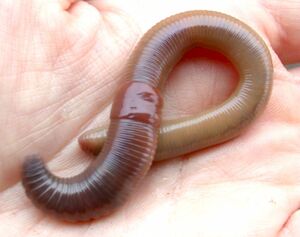American Bullfrog
(Lithobates catesbeianus) or the American Bullfrog as it is more commonly known is a member of the true frog family found natively in Eastern North America. With its large size compared to other frog species the species is able to inhabit a wide variety of aquatic environments with relative success. The American Bullfrog gets its name from the male call during breeding season resembling a bulls bellow.

| |
| Kingdom: | Animalia |
|---|---|
| Phylum: | Annelida |
| Class: | Clitellata |
| Order: | Opisthopora |
| Family: | Lumbricidae |
| Genus: | Lumbricus |
| Species: | L. terrestris |
| Source: Integrated Taxonomic Information System[1] | |
Description
Bullfrogs are an olive green color with spotting of brown marks observed on it's back and sides.
Habitat
Due to the large size compared to other species of frog, the American Bullfrog is hunted and consumed by countries all over the world as a source of food. With this introduction into new environments as food sources, due to the diverse appetite American Bullfrogs are considered invasive species in its unnatural habitat.
Diet
The Bullfrog is known to eat a variety of organisms most typically being invertebrates including species of snail, worm, and insect. However due to the opportunistic behavior of the American Bullfrog the species has been dissected and found to eat species of rodents, small snakes and birds, and are even found to be cannibalistic. This feeding behavior is a major factor into the American Bullfrog being observed as invasive due to the introduction of the species affecting native species of salamanders and other smaller amphibians.
Feeding
American Bullfrogs are observed to be ambush and opportunistic predators, feeding on a variety of animals unsuspecting of their presence. Once its prey has been located it moves towards the prey using a series of hops to sneak up on its meal. Using its tongue and strong bite from the jaw smaller prey are consumed and engulphed using its mouth. Larger prey that are not able to fit in the American Bullfrogs mouth have been observed to be assisted using its hands, with larger prey observed to be asphyxiated after a successful catch as a defense mechanism. This behavior mimics other forms of feeding from other frogs, most notably a wood frog [2].
Ecology
References
- ↑ "Integrated Taxonomic Information System - Report", ITIS USGS Open-File Report 2006-1195: Nomenclature", USGS, n.d.. Retrieved 5/1/2022.
- ↑ 2.0 2.1 Cardini, F. (1974). Specializations of the Feeding Response of the Bullfrog, Rana catesbeiana, for the Capture of Prey Submerged in Water. M.S. Thesis, U. of Massachusetts, Amherst, MA